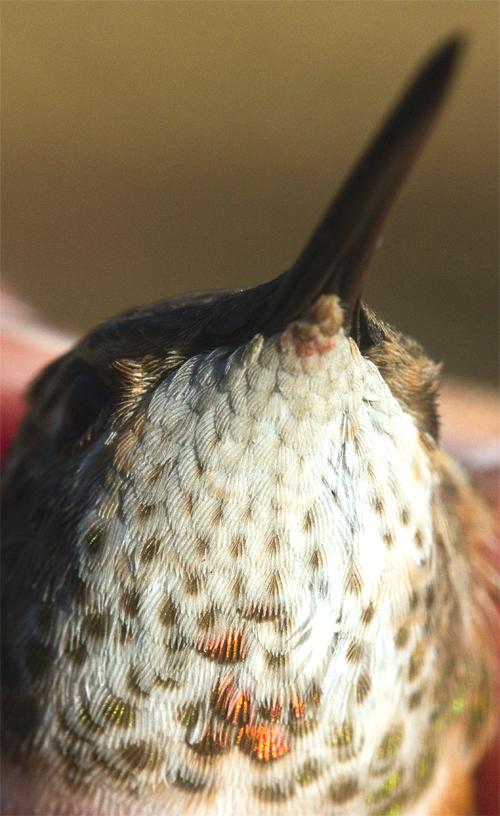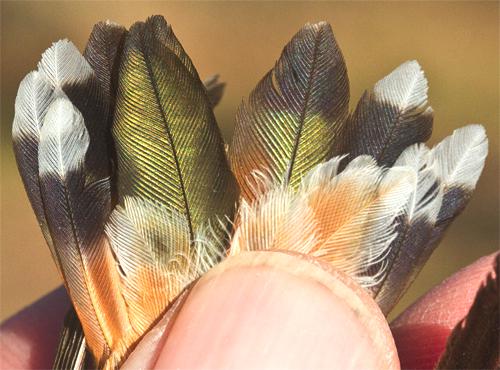|
|
|||
RUFOUS HUMMINGBIRD |
It had been almost exactly six years since we captured the first Rufous Hummingbird ever banded in West Virginia--only the second confirmed state record for the species-- We got wind of the 2012 bird from two different sources. The homeowner-hostess first contacted Wendy Perrone--executive director of Three Rivers Avian Center in Brooks WV--who in turn sent us an e-mail. At about the same time, Fayette County resource manager Dave Pollard heard from Traci Sutphin (an associate at the courthouse) that her sister was hosting a winter hummer; it was, in fact, the same bird reported by Wendy. (Ironically, Traci had opportunity to hold and release one of our banded Ruby-throated Hummingbirds during a hummer festival in West Virginia.) After making a few inquiries Dave--with whom we work on planning and program implementation for New River Birding & Nature Center--arranged for us to visit the home of Debra Barker, who had been observing her vagrant Oak Hill hummer for at least a couple of weeks.
All text & photos © Hilton Pond Center Dave--Rachel Davis of the Nature Center staff--came along for our visit to the Barker residence, where we arrived shortly before 2 p.m. While watching a freshly filled hummingbird feeder hanging in the open backyard, we talked for a few minutes and then set up our portable capture device, moving the feeder inside the trap, activating the battery-powered sliding door, and standing back to wait for the hummer to appear. It didn't take long. After about ten minutes or so the hummingbird flew straight to the trap but had trouble finding the entry door; instead it explored the sides, top, and bottom of the trap and even clung several times to the wire mesh wall before buzzing off.
All text & photos © Hilton Pond Center Over the next ten minutes the hungry bird made several trips back and forth to the trap, sometimes perching in full view on tree branches overhead. With binoculars we could see cinnamon-colored flanks and some rust in the tail and a lightly marked gorget--all of which led us to speculate this was an immature female Selasphorus hummingbird--either a Rufous (S. rufus) or an Allen's (S. sasin). Eventually the hummer made its way through the trap's open door and sat on the feeder perch to drink, at which point we flicked the switch to remotely release a pin holding the door open and the bird was safely captured.
All text & photos © Hilton Pond Center A quick in-hand examination indicated the bird was indeed an immature--the face was indistinctly marked--and its relatively large size and the tiny, scattered iridescent feathers showed it was probably female. The best way to determine sex for many hummingbirds is through measurements--females are somewhat larger among Selasphorus hummers (and in Ruby-throated Hummingbirds, Archilochus colubris)--so we placed the bird in a paper tube, set up shop in the back of our trusty Ford van, and began measuring.
All text & photos © Hilton Pond Center Using a small portable scale we found the bird weighed 3.95 grams, a good sign she was healthy and getting ample food from the sugar water feeder AND from tiny gnats, aphids, and other insects and arthropods present even on most cold winter days. We measured the tail as it extended from the tube, the length being a typical 28mm; we also could see the rusty-based rectrices (tail feathers, above) were all at least 3mm wide. The latter info confirmed this was a Rufous Hummingbird because an Allen's Hummingbird's tail feathers are much narrower.
All text & photos © Hilton Pond Center The wing chord of this newly captured hummer was 46.12mm, which confirmed our speculation she was a female. (Male Rufous Hummingbirds have wing chords in the 38.1mm to 42.5mm range, while females come in at 42.6-46.6mm.) The bird's wing measure also further ruled out the smaller Allen's Hummingbird that has a wing chord of 43.3mm or less. (Incidentally, further examination of our rufous hummer's wing showed she had molted primary feathers 1-6 while retaining feathers 7-10. This is typical of winter hummers we have banded in the eastern U.S. and suggests partial wing molt occurred prior to migration; our on-going Neotropical field studies confirmed wing and tail molt don't occur in Ruby-throated Hummingbirds of either sex until well after they get to their wintering grounds in Mexico and Central America.) The Oak Hill hummingbird's culmen (upper ridge of the upper mandible) measured 18.5mm--another sign she was indeed female (16.4-19mm) rather than a male (14.4-18mm). We carefully and permanently marked the hummer using a tiny aluminum ring inscribed with #H80902 and applied to the right leg. (We band all our males on the left leg, all females and birds of unknown sex on the right.) We then documented the whole encounter with the series of photos shown on this page. We thank Wendy Perrone, Traci Sutphin, and Dave Pollard for communicating with us about the Rufous Hummingbird at Oak Hill and especially appreciate the enthusiasm of Debra Barker in allowing us to band her winter vagrant. We already know of a few other hummers in West Virginia this winter season and hope to get to them as time and travels allow. Please report any sightings of winter vagrant hummingbirds in the Mountain State and elsewhere east of the Rockies by sending an e-mail to RESEARCH and we'll do our best to visit them ourselves or find another bander to confirm identification through the capture, measurement, and banding process outlined above. All text & photos © Hilton Pond Center Vital Statistics for All text & photos © Hilton Pond Center
If you're interested in sharing your hummingbird observations and learning from other enthusiasts, you may wish to subscribe to Hummingbird Hobnob, our Yahoo!-based discussion group. Also be sure to visit our award-winning Web site for Operation RubyThroat: The Hummingbird Project; on it you'll find almost anything you want to know about hummingbirds, including more information about Hummingbird Banding. You may also wish to read more about Winter Hummingbirds that are showing up in the eastern U.S. To join one of our Central American hummingbird expeditions as a citizen scientist, see: |
 The Piedmont Naturalist, Volume 1 (1986)--long out-of-print--has been re-published by author Bill Hilton Jr. as an e-Book downloadable to read on your iPad, iPhone, Nook, Kindle, or desktop computer. Click on the image at left for information about ordering. All proceeds benefit education, research, and conservation work of Hilton Pond Center for Piedmont Natural History. The Piedmont Naturalist, Volume 1 (1986)--long out-of-print--has been re-published by author Bill Hilton Jr. as an e-Book downloadable to read on your iPad, iPhone, Nook, Kindle, or desktop computer. Click on the image at left for information about ordering. All proceeds benefit education, research, and conservation work of Hilton Pond Center for Piedmont Natural History. |
|
"This Week at Hilton Pond" is written and photographed by Bill Hilton Jr., executive director of Hilton Pond Center for Piedmont Natural History |
|
Please refer "This Week at Hilton Pond" to others by clicking on this button: |
Comments or questions about this week's installment? Send an E-mail to INFO. (Be sure to scroll down for a tally of birds banded/recaptured during the period, plus other nature notes.) |

Click on image at right for live Web cam of Hilton Pond,
plus daily weather summary
Transmission of weather data from Hilton Pond Center via WeatherSnoopfor Mac.
--SEARCH OUR SITE-- For a free on-line subscription to "This Week at Hilton Pond," send us an |
If you enjoy "This Week at Hilton Pond," please help support Hilton Pond Center for Piedmont Natural History. It's painless, and YOU can make a difference! (Just CLICK on a logo below or send a check if you like; see Support for address.) |
|
Make credit card donations on-line via Network for Good: |
|
Use your PayPal account to make direct donations: |
|
If you like shopping on-line please become a member of iGive, through which 950+ on-line stores from Amazon to Lands' End and even iTunes donate a percentage of your purchase price to support Hilton Pond Center.  Every new member who registers with iGive and makes a purchase through them earns an ADDITIONAL $5 for the Center. You can even do Web searches through iGive and earn a penny per search--sometimes TWO--for the cause! Please enroll by going to the iGive Web site. It's a painless, important way for YOU to support our on-going work in conservation, education, and research. Add the iGive Toolbar to your browser and register Operation RubyThroat as your preferred charity to make it even easier to help Hilton Pond Center when you shop. Every new member who registers with iGive and makes a purchase through them earns an ADDITIONAL $5 for the Center. You can even do Web searches through iGive and earn a penny per search--sometimes TWO--for the cause! Please enroll by going to the iGive Web site. It's a painless, important way for YOU to support our on-going work in conservation, education, and research. Add the iGive Toolbar to your browser and register Operation RubyThroat as your preferred charity to make it even easier to help Hilton Pond Center when you shop. |
|
|
You are not obligated to click on the link.

 so when we were in the Mountain State for consulting work the last week in November 2012 we jumped at news a winter vagrant hummer was coming to a home in Oak Hill just a few miles from our work site. We caught that first rufous six years ago (left) on
so when we were in the Mountain State for consulting work the last week in November 2012 we jumped at news a winter vagrant hummer was coming to a home in Oak Hill just a few miles from our work site. We caught that first rufous six years ago (left) on 




 After placing the bird's bill in the feeder port--she drank readily and at length--we presented the little ball of fluff to our hostess. This just-banded hummer--to our knowledge only the fourth banding of a Rufous Hummingbird for the state of West Virginia (others have been captured near Wheeling and in Jefferson County)--sat calmly in Debra's hand (right) for a minute or two until gently nudged. With that the bird came to attention and took off rapidly for a nearby tree where she perched and fluffed her feathers as follow-up to the banding experience. With our afternoon's work complete, it was nice to get another confirmation for Rufous Hummingbirds wintering in West Virginia--especially knowing this particular bird is inside the area for the annual Oak Hill Christmas Bird Count. She'll be an exotic addition to the local CBC species list if she hangs around long enough to be tallied.
After placing the bird's bill in the feeder port--she drank readily and at length--we presented the little ball of fluff to our hostess. This just-banded hummer--to our knowledge only the fourth banding of a Rufous Hummingbird for the state of West Virginia (others have been captured near Wheeling and in Jefferson County)--sat calmly in Debra's hand (right) for a minute or two until gently nudged. With that the bird came to attention and took off rapidly for a nearby tree where she perched and fluffed her feathers as follow-up to the banding experience. With our afternoon's work complete, it was nice to get another confirmation for Rufous Hummingbirds wintering in West Virginia--especially knowing this particular bird is inside the area for the annual Oak Hill Christmas Bird Count. She'll be an exotic addition to the local CBC species list if she hangs around long enough to be tallied.


